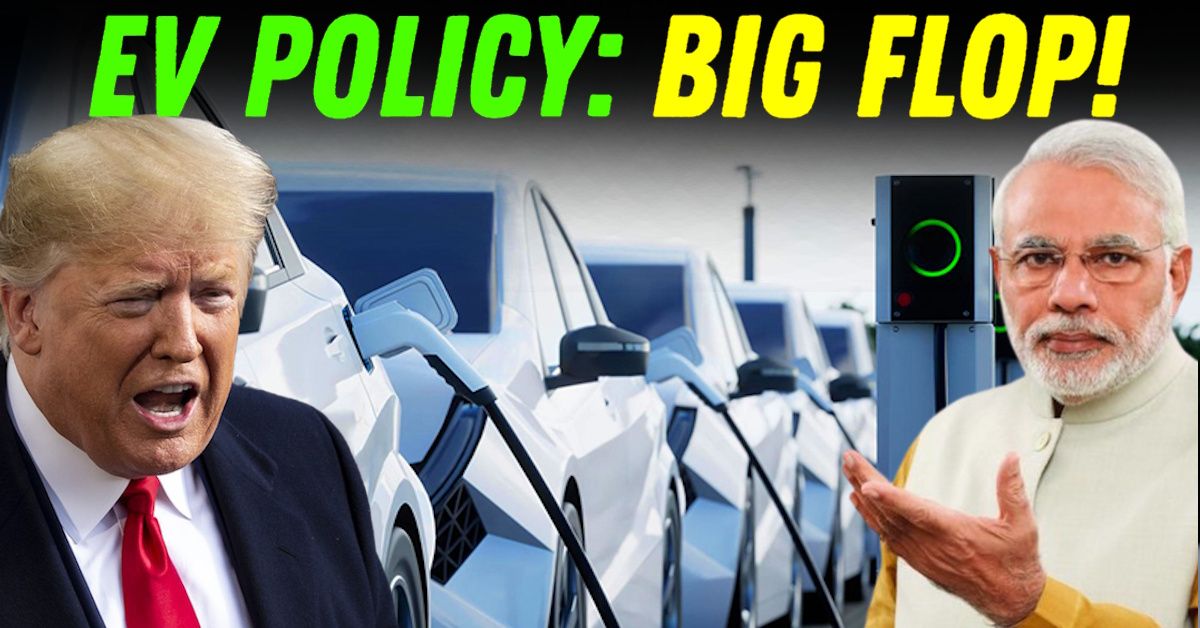India's New EV Policy: A Mega Flop, Thanks to Trump? We Explain


India's ambitious push toward electric vehicles (EVs) has hit a significant roadblock. The recently introduced Scheme for Manufacturing of Electric Cars Policy (SMEPCI) aimed to attract global automakers while boosting domestic EV production. However, the policy has faced criticism for its limited success, and the ongoing negotiations around trade agreements like Free Trade Agreements (FTAs) or Bilateral Trade Agreements (BTAs) have further complicated matters. Adding to the intrigue is former US President Donald Trump's reported influence on Tesla's India plans, which has raised eyebrows globally.
The SMEPCI slashed import duties on premium EVs priced above $35,000 from 110% to 15%, provided manufacturers invest ₹4,150 crore ($500 million) in local production within three years.
The policy also mandated localisation targets—25% within three years and 50% within five years—aiming to encourage domestic manufacturing and reduce dependence on imports.
India's broader EV goals remain ambitious: achieving 30% EV penetration in passenger cars and 80% in two- and three-wheelers by 2030. The Union Budget 2025-26 further supported this vision with a 114% increase in funding for EV infrastructure under the PM E-Drive Scheme and a massive 713% jump in incentives for automotive components and batteries. Despite these efforts, the policy has failed to generate the desired enthusiasm among global automakers.
Global automakers like Tesla, Volkswagen, BMW, and Mercedes-Benz have largely put their India plans on hold. Instead of committing to SMEPCI's stringent localisation requirements, they are waiting for more favourable terms under FTAs or BTAs currently under negotiation. For instance, Tesla has leased showroom space in Mumbai but appears reluctant to commit to local manufacturing until trade agreements offer better concessions.
Domestic players like Tata Motors and Mahindra have expressed concerns that reduced import duties could undermine their investments in local EV ecosystems. Jaguar Land Rover (JLR), a subsidiary of Tata Motors, recently scrapped its plans to manufacture EVs locally due to cost concerns and slowing demand.
Several factors contribute to the delay:
• High Investment Risks: Global automakers find SMEPCI's ₹4,150 crore investment requirement risky given India's relatively small premium EV market, which accounts for just 2% of total car sales.
• FTA/BTA Negotiations: Automakers are eyeing FTAs or BTAs with the US and EU, which could offer reduced tariffs without localisation commitments.
• Uncertain Demand: Slowing demand for luxury EVs and competition from Chinese manufacturers have made India a less attractive market for global players.
• Policy Overlaps: Frequent policy changes and lack of long-term clarity have eroded investor confidence.
If an FTA or BTA is signed, it could significantly impact Indian EV buyers:
• Lower Prices: Reduced import duties could make premium EVs more affordable. For instance, a Tesla Model Y currently priced at ₹70 lakh could drop by ₹15–20 lakh under lower tariffs.
• Wider Choices: Buyers would gain access to a broader range of international models without waiting for local production.
• Market Dynamics: Affordable imports could pressure domestic manufacturers to improve quality and pricing.
However, there are potential drawbacks. Imported EVs might still remain out of reach for middle-class buyers due to their premium pricing. Moreover, increased imports could slow down the development of domestic charging infrastructure as foreign automakers may not invest heavily in local ecosystems.
Indian automakers could face significant challenges if FTAs or BTAs are signed:
• Competitive Pressure: Domestic players like Tata Motors and Mahindra would struggle to compete with cheaper imports from global giants.
• Investment Risks: Reduced localisation requirements under FTAs would discourage foreign investment in Indian manufacturing facilities.
• Supply Chain Disruption: Domestic suppliers might lose business as foreign automakers rely on their existing global supply chains.
On the flip side, some argue that increased competition could drive innovation among Indian manufacturers. However, this would require substantial government support in the form of subsidies or tax breaks.
The next six months will be crucial for India's EV landscape:
1. Policy Adjustments: The government may revise SMEPCI to address industry concerns, possibly relaxing localisation norms or extending deadlines.
2. FTA/BTA Developments: The outcome of trade negotiations with the US and EU will heavily influence market dynamics.
3. Price Parity: Union Minister Nitin Gadkari recently predicted that EVs would achieve price parity with petrol cars within six months due to advancements in battery technology. If true, this could accelerate mass adoption.
4. Launches by Domestic Players: Indian automakers are set to introduce several new models in 2025, including Tata's Harrier EV and Maruti Suzuki's e-Vitara.
India's new EV policy was designed as a bold step toward electrification but has faltered due to its stringent requirements and lack of alignment with global market realities. Automakers are clearly waiting for more favourable terms through FTAs or BTAs rather than committing under SMEPCI's current framework. While these trade agreements could benefit consumers through lower prices and wider choices, they pose significant risks to domestic manufacturers struggling to compete with global giants.
In the coming months, much will depend on how India balances its dual objectives: attracting foreign investment while protecting its nascent domestic EV industry. Until then, India's journey toward becoming a global EV hub remains uncertain.